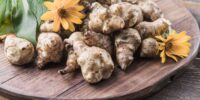Prebiotic Spotlight: Prebiotic Blends
Each edition of GPA’s Prebiotic Spotlight focuses on a specific prebiotic type to raise awareness around the prebiotic itself, its sources, any notable and/or recent research, and how it is used in the marketplace. In this issue, prebiotic blends are highlighted.
Overview
Prebiotic fibers such as inulin, resistant starch (RS, types I-IV), and fructooligosaccharides (FOS) are non-digestible carbohydrates that have gained increasing attention for their ability to positively modulate the gut microbiota (Namkieat et al., 2025). Their fermentation generates short-chain fatty acids (SCFAs), metabolites associated with a wide range of positive health outcomes (Hall et al., 2024). Numerous studies have examined the distinct benefits of individual prebiotics; for example, inulin’s potential metabolic effects and FOS’s reported improvement in inflammation and endothelial function in individuals with kidney disease (Ahmed & Rashid, 2019; Armani et al., 2021). Beyond fiber-based prebiotics, non-fiber compounds such as polyphenols, including curcumin, quercetin, and catechins, also demonstrate prebiotic activity, with effects that vary depending on the microbial strains present (Shabbir et al., 2021). Increasing scientific and commercial interests now highlight the potential value of combining multiple prebiotic types in a single formulation, as each type possesses unique structural and fermentative properties that lead to distinct health benefits (Davani-Davari et al., 2019).
Benefit Areas
In recent years, numerous studies have demonstrated an association between supplementation with prebiotic blends and various health benefits, including:
· A food product containing oligo-fructose enriched inulin, galactooligosaccharides (GOS), high-amylose corn starch, cocoa, green tea extract, cranberry extract, and blueberry powder mitigated hypoxia-induced increases in intestinal permeability in the small intestine and colon, increased Bifidobacterium abundance, and decreased alpha-diversity and colonic pH in healthy participants (Karl et al., 2025).
· A prebiotic blend (containing FOS, inulin, resistant dextrin, resistant maltodextrin, partially hydrolysed guar gum, and guar gum) taken at 10 g daily plus healthy eating advice led to reductions in high sensitivity C-reactive protein, perceived stress, anxiety, and depression in adults with metabolic syndrome (Hall et al., 2024).
· Dietary supplementation with a gut microbiota-targeted complementary food, containing chickpea, soybean, peanut, green banana, sugar, and soybean oil, along with a vitamin and mineral blend, led to higher citrulline concentrations in malnourished children, which indicates an increase in total mass of enterocytes, and may be associated with decreased gut permeability, compared with those receiving a ready-to-use supplementary food (RUSF) (Mostafa et al., 2024).
· A microbiota-directed complementary food led to greater recovery rates and was associated with an increased Prevotella copri abundance compared to RUSF, among children with severe acute malnutrition (SAM) (Hartman et al., 2024).
Sources
The Global Prebiotic Association (GPA) defines a prebiotic as ‘a compound or ingredient that is utilized by the microbiota producing a health or performance benefit’ (Deehan et al., 2024). Prebiotics include several types of compounds found naturally in foods such as fruits, vegetables, and grains. Major categories consist of 1) fructans, including inulin and FOS; 2) GOS; 3) starch- and glucose-derived oligosaccharides such as RS and polydextrose; 4) pectin-derived oligosaccharides; and 5) non-carbohydrate oligosaccharides. Common dietary sources include asparagus, chicory, sugar beet, onions, Jerusalem artichoke, wheat, honey, bananas, and human and cow milk. In addition, lactose, sucrose, and starch are often used as raw materials in the commercial production of prebiotics (Davani-Davari et al., 2019). A ‘prebiotic blend’ typically refers to a formulation that combines multiple types of prebiotics, such as RS and inulin, each originating from different dietary sources.
Dose Range
According to the International Scientific Association for Probiotics and Prebiotics (ISAPP), there are currently no official dietary intake recommendations for prebiotics in healthy individuals (ISAPP, 2020). Although most prebiotics require an efficacious dose of ≥3 g/day to confer health benefits, different formulations and different dosages can modulate the gut microbiota in distinct ways. For example, daily supplementation with 12 g of prebiotic fiber blend containing FOS, RS, sugarcane fiber, inulin, gum Arabic, xanthan gum, and fruit powders significantly increased Actinobacteria and several Bifidobacterium species in healthy adults with a low habitual fiber intake (Kang et al., 2022). In another study, patients with adenomatous polyps who consumed 7 g/day of a blend of GOS, FOS, and isomaltooligosaccharides (9:1:1 ratio) demonstrated a significant increase in interleukin-10, indicative of a reduced inflammatory response, and an increasing trend in Unclassified Clostridiales, Bifidobacteriaceae, Unidentified Ruminococcaceae, and Bifidobacterium (Meng et al., 2025). Additionally, adults with multiple dysfunction-associated steatotic liver disease who received 16 g/day of oligofructose-enriched inulin demonstrated increased abundance of Bifidobacterium (Mayengbam et al., 2025). Collectively, these findings support tailoring prebiotic dosage to specific populations, as individuals with conditions such as inflammatory bowel disease or irritable bowel syndrome may require adjusted amounts to optimize benefits while minimizing common gastrointestinal side effects (Hu et al., 2024).
Recent Research
Research on prebiotic blends has expanded in recent years due to their potential health benefits. A search for ‘prebiotic blends’ on ClinicalTrials.gov yielded 28 studies that are
recruiting, completed, or newly registered, many of which examine the effects of various blend formulations and gut microbiome and gastrointestinal, cognitive, metabolic, and immune health (ClinicalTrials.gov, 2025). On PubMed, searching ‘prebiotic blends,’ filtered for clinical trials or randomized controlled clinical trials published within the last 10 years, retrieved 17 articles, three of which were published in 2025, addressing topics such as inflammation, microbiota composition and function, cytokine responses, weight management, and more (PubMed, 2025).
Voigt et al. (2025) conducted a 12-week double-blind, placebo-controlled pilot study evaluating cognitive behavioral therapy in combination with prebiotic fiber supplementation in veterans with posttraumatic stress disorder (PTSD). Participants received psychological intervention with either 10 g of a prebiotic blend containing RS type II, rice bran, resistant maltodextrin, and inulin, or placebo, consuming one bar daily for the first week and two bars daily for the remainder of the study. PTSD symptom severity (PCL-5 score) and stool samples were assessed. Overall, the prebiotic blend did not significantly improve PCL-5 scores; however, reduced abundance of propionate-producing taxa, including Monoglobus, unclassified Oscillospiraceae, and Ruminococcaceae was associated with greater PTSD severity. A post hoc analysis showed that males receiving the blend had significantly reduced PCL-5 scores at weeks 2 and 12, while the placebo group showed reductions only at week 2. Overall, PTSD severity may be linked to reduced abundance of propionate-producing bacteria and that prebiotic intervention may benefit male veterans with PTSD.
Rattigan et al. (2025) conducted two randomized crossover trials in children aged 6 to <24 months old with SAM and moderate acute malnutrition (MAM) to compare the acceptability of a novel microbiome-directed food (MDF) with standard nutritional therapies (i.e., RUSF and ready-to-use therapeutic food (RUTF)). The children were randomized to receive MDF then standard nutritional care, or vice versa. The MDF formulation included chickpea flour, soy flour, peanut paste, green banana, oil, sugar, and micronutrients. Caregivers administered either MDF (100 g/sachet) and RUTF (92 g/sachet) for children with SAM or MDF (100 g/sachet) and RUSF (100 g/sachet) for children with MAM, following two 14-day periods of at-home consumption separated by an in-clinic test dose before switching to the second study food. The children with SAM only received the study food with no at-home food while children with MAM were allowed the study food plus their usual diet. Acceptability was the primary outcome, with the secondary outcomes including perceived liking, willingness for future use, sharing behavior, and consumption frequency. Overall, MDF was non-inferior to RUTF for SAM and to RUSF for MAM in at-home acceptability; however, during test doses, MDF and RUTF were similarly accepted in SAM, while MDF was less acceptable than RUSF in MAM. For at-home use, children with SAM liked both products similarly, but caregivers seemed to prefer MDF over RUTF due to more rapid weight gain and health improvement. Regarding at-home consumption among children with MAM, no difference was reported in child’s liking of the consumed food, but caregivers tended to prefer MDF over RUSF for its association with fewer symptoms, such as diarrhea, and
more rapid growth. These findings suggest that this novel MDF, containing a blend of prebiotic ingredients, is an acceptable option for managing SAM and MAM in children.
How are prebiotic blends used in the marketplace?
According to Future Market Insights (FMI), the prebiotic fiber market is projected to grow from USD 7.1 billion in 2025 to USD 13.1 billion by 2035, reflecting a compound annual growth rate (CAGR) of 6.3%, with the food and beverage sector representing the leading application area. Although the report primarily examines individual prebiotic ingredients, FMI highlights emerging trends in personalized nutrition that are driving innovation in prebiotic fiber blends and clinically substantiated formulations. The analysis also notes growing interest in blends containing GOS (FMI, 2025). Additional key drivers of growth in the prebiotics market include incorporation of prebiotic fibers into dairy alternatives and health beverages, rising demand for clean-label and organic ingredients, and increased global visibility of prebiotic supplements through e-commerce platforms.
References:
Armani, R. G., Carvalho, A. B., Ramos, C. I., Hong, V., Bortolotto, L. A., Cassiolato, J. L., Oliveira, N. F., Cieslarova, Z., do Lago, C. L., Klassen, A., Cuppari, L., Raj, D. S., & Canziani, M. E. F. (2021). Effect of fructooligosaccharide on endothelial function in CKD patients: a randomized controlled trial. Nephrology, dialysis, transplantation : official publication of the European Dialysis and Transplant Association – European Renal Association, 37(1), 85–91. https://doi.org/10.1093/ndt/gfaa335
Ahmed, W., & Rashid, S. (2019). Functional and therapeutic potential of inulin: A comprehensive review. Critical reviews in food science and nutrition, 59(1), 1–13. https://doi.org/10.1080/1040839.2017.1355775
ClinicalTrials.gov. (2025). Prebiotic Blends. Retrieved on: November 11, 2025. Available from https://clinicaltrials.gov/search?intr=prebiotic%20blends
Davani-Davari, D., Negahdaripour, M., Karimzadeh, I., Seifan, M., Mohkam, M., Masoumi, S. J., Berenjian, A., & Ghasemi, Y. (2019). Prebiotics: Definition, Types, Sources, Mechanisms, and Clinical Applications. Foods (Basel, Switzerland), 8(3), 92. https://doi.org/10.3390/foods8030092
Deehan, E. C., Al Antwan, S., Witwer, R. S., Guerra, P., John, T., & Monheit, L. (2024). Revisiting the Concepts of Prebiotic and Prebiotic Effect in Light of Scientific and Regulatory Progress-A Consensus Paper From the Global Prebiotic Association. Advances in nutrition (Bethesda, Md.), 15(12), 100329. https://doi.org/10.1016/j.advnut.2024.100329
Future Market Insights. (2025). Prebiotic Fiber Market. Retrieved on: September 2025. Available fromhttps://www.futuremarketinsights.com/reports/prebiotic-fiber-market?
Hall, C. V., Hepsomali, P., Dalile, B., Scapozza, L., & Gurry, T. (2024). Effects of a diverse prebiotic fibre blend on inflammation, the gut microbiota and affective symptoms in metabolic syndrome: a pilot open-label randomised controlled trial. The British journal of nutrition, 132(8), 1002–1013. https://doi.org/10.1017/S0007114524002186
Hu, Y., Aljumaah, M. R., & Azcarate-Peril, M. A. (2024). Galacto-Oligosaccharides and the Elderly Gut: Implications for Immune Restoration and Health. Advances in nutrition (Bethesda, Md.), 15(8), 100263. https://doi.org/10.1016/j.advnut.2024.100263
International Scientific Association for Probiotics and Prebiotics (ISAPP). (2020). The science of prebiotics. Cereal & Grains Association, 65(3). https://doi.org/10.1094/CFW-65-3-0027
Karl, J. P., Fagnant, H. S., Radcliffe, P. N., Wilson, M., Karis, A. J., Sayers, B., Wijeyesekera, A., Gibson, G. R., Lieberman, H. R., Giles, G. E., & Soares, J. W. (2025). Gut microbiota-targeted dietary supplementation with fermentable fibers and polyphenols prevents hypobaric hypoxia-induced increases in intestinal permeability. American journal of physiology. Regulatory, integrative and comparative physiology, 329(3), R378–R399. https://doi.org/10.1152/ajpregu.00109.2025
Mayengbam, S., Raman, M., Parnell, J. A., Eksteen, B., Lambert, J. E., Eller, L. K., Nicolucci, A. C., Aktary, M. L., & Reimer, R. A. (2025). Effects of combined prebiotic fiber supplementation and weight loss counseling in adults with metabolic dysfunction-associated steatotic liver disease: a randomized controlled trial. European journal of nutrition, 64(4), 144. https://doi.org/10.1007/s00394-025-03660-7
Meng, S., Liu, C., Zhang, K., Li, J., Wang, D., Zhao, J., Wang, Y., Du, M., Li, C., Wang, Y., Lu, W., & Zhu, Y. (2025). A Prebiotic-Supplemented Formula Improves Gut Microbiota and Intestinal Inflammatory Microenvironment in Patients with Colorectal Adenoma: A Double-Blind, Placebo-Controlled Trial. The Journal of Nutrition. https://doi.org/10.1016/j.tjnut.2025.09.005
Mostafa, I., Sthity, R. A., Lamiya, U. H., Tariqujjaman, M., Mahfuz, M., Hasan, S. M. T., & Ahmed, T. (2024). Effect of Gut Microbiota-Directed Complementary Food Supplementation on Fecal and Plasma Biomarkers of Gut Health and Environmental Enteric Dysfunction in Slum-Dwelling Children with Moderate Acute Malnutrition. Children (Basel, Switzerland), 11(1), 69. https://doi.org/10.3390/children11010069
Namkieat, P., Borompichaichartkul, C., Phumsombat, P., Ayuni, D., & Sapwarobol, S. (2025). Comparison of the functional properties between tapioca-resistant maltodextrin and commercial prebiotics, International Journal of Food Science and Technology, Volume 60, Issue 1, January 2025, vvaf033, https://doi.org/10.1093/ijfood/vvaf033
PubMed. (2025). Prebiotic Blends. Retrieved on: November 11, 2025. Available from https://pubmed.ncbi.nlm.nih.gov/?term=prebiotic%20blends&filter=datesearch.y_10&filter=pubt.clinicaltrial&filter=pubt.randomizedcontrolledtrial&page=2
Rattigan, S. M., Mbouombouo, I. N., Abdou Tahirou, M. A., Mostafa, I., Saqeeb, K. N., Garba, S., Guindo, O., Ahmed, T., Barratt, M. J., Gordon, J. I., Sudfeld, C. R., Grais, R. F., & Isanaka, S. (2025). Acceptability of a Microbiome-Directed Food for the Management of Children with Uncomplicated Acute Malnutrition in Maradi, Niger: Two Randomized Crossover Trials. Current developments in nutrition, 9(7), 107484. https://doi.org/10.1016/j.cdnut.2025.107484
Shabbir, U., Rubab, M., Daliri, E. B.-M., Chelliah, R., Javed, A., & Oh, D.-H. (2021). Curcumin, Quercetin, Catechins and Metabolic Diseases: The Role of Gut Microbiota. Nutrients, 13(1), 206. https://doi.org/10.3390/nu13010206
Voigt, R. M., Engen, P. A., Villanueva, M., Bambi, S. A., Green, S. J., Naqib, A., Raeisi, S., Shaikh, M., Hamaker, B. R., Cantu-Jungles, T. M., Pridgen, S. A., Held, P., & Keshavarzian, A. (2025). Prebiotics as an adjunct therapy for posttraumatic stress disorder: a pilot randomized controlled trial. Frontiers in neuroscience, 18, 1477519. https://doi.org/10.3389/fnins.2024.1477519




